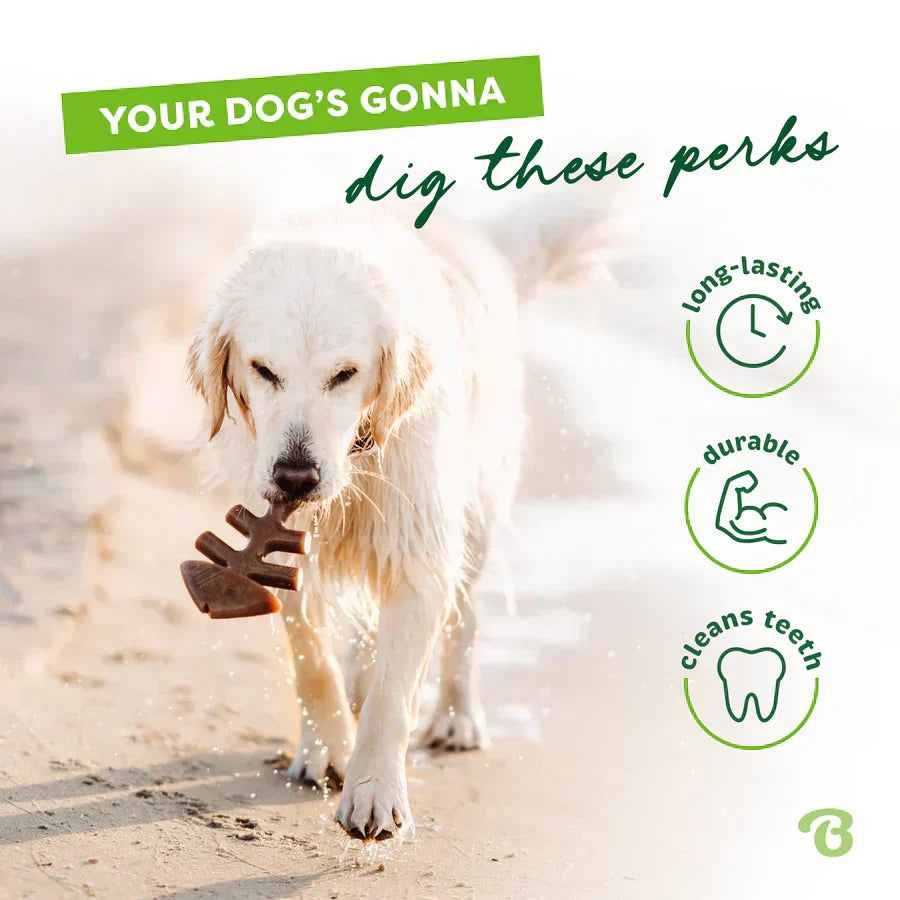
Are Benebones Safe for Dogs?
Are Benebones Safe for Dogs? Safety Guide, Sizing, and Vet‑Aligned Tips
Benebones are popular nylon chews infused with real flavours that keep many dogs busy. But are Benebones safe for your dog? The short answer: they can be, when you pick the right size, supervise every session, and replace the chew as soon as it shows sharp wear. Below, we break down how to choose the right Benebone, how to use it safely, and when to consider gentler alternatives—plus our top picks for power chewers.
Quick Answer
- Generally safe for many adult dogs when sized correctly and used under supervision.
- Not ideal for extreme power chewers, puppies with baby teeth, or dogs with dental disease/history of tooth fractures.
- Replace immediately if sharp edges form, it’s chewed down below the recommended length, or any piece breaks off.
What Are Benebones Made Of? Benebones are made from durable nylon with flavour compounds (like real bacon, chicken, or peanut) infused into the material. Nylon is harder than most rubber toys, so it satisfies dogs who enjoy persistent gnawing. Unlike edible chews, nylon chews aren’t meant to be consumed; tiny surface shavings can occur, but dogs shouldn’t swallow chunks.
- Nylon vs rubber: Rubber toys flex and absorb force, which is gentler on teeth. Nylon is rigid and can wear more slowly, but it may increase tooth stress for very hard chewers.
- Nylon vs edible chews: Edible dental treats are designed to break down; nylon is for mechanical gnawing enrichment and longevity.
Key Safety Factors
- Chew style
- Gentle to moderate gnawers: Often suitable with the right size and close supervision.
- Power chewers (jawy, goal‑oriented chewers determined to fracture objects): Higher risk of tooth damage or breaking off pieces. Consider tougher, slightly more forgiving rubber options.
- Age and dental health
- Puppies: Avoid until adult teeth are fully in (typically 6–12 months). Baby teeth and developing jaws are vulnerable.
- Seniors or dogs with dental disease: Hard chews can aggravate issues; consult your vet.
- Size and shape
- Always choose a size larger than your dog’s mouth. Larger chews reduce the leverage dogs can get on their back molars.
- Shapes that create “edges” can concentrate force—inspect frequently.
- Supervision and setting
- Supervise every session, especially the first few uses.
- Keep sessions reasonable (see guidance below) and provide fresh water.
- Remove the chew once you notice aggressive attempts to snap or crush it.
How to Choose the Right Benebone Size Use the manufacturer’s weight guide and when in doubt, size up. The goal is a chew that can’t be crunched between the back molars like a stick.
- Small dogs (up to ~9 kg): Small/Medium sizes
- Medium dogs (~10–22 kg): Medium/Large
- Large dogs (~23–34 kg): Large/XL
- Giant breeds (35 kg+): XL Add your dog’s chew style to the equation—moderate chewers can follow the standard guide; stronger chewers should go one size up and consider alternative materials if they try to snap rather than gnaw.
Insert internal link block:
- Shop Benebone chews [link to Benebone category or key SKU]
- Not sure on size? Message us and we’ll recommend the safest fit for your dog.
How to Use Benebones Safely
- Start slow: Introduce 5–10 minute sessions for the first few days. Observe how your dog interacts—steady scraping/gnawing is good; grinding and levering with molars is a red flag.
- Daily inspection: Run your finger along the chew. If you feel sharp, blade‑like edges, retire it. Check for cracks, gouges, or missing pieces.
- Replace proactively: Don’t wait until the chew is tiny. Follow the brand’s minimum length guidance and replace at the first signs of risky wear.
- Rotate textures: Mix in softer, tough rubber toys during the week to reduce tooth stress and keep enrichment varied.
- Provide water and a calm environment: Hydration and a distraction‑free spot help dogs settle into safer gnawing patterns.
Signs You Should Replace a Benebone
- Edges feel sharp or look thinned into “knife” points
- The chew is worn down below the brand’s recommended minimum length
- Visible cracks, splits, or missing chunks
- Your dog is trying to snap off pieces rather than scrape/gnaw
- Any piece breaks off—remove immediately and replace
Potential Risks (and How to Minimise Them)
- Tooth fractures: Most likely in extreme chewers or dogs with existing dental vulnerabilities. Mitigate by sizing up, limiting session length, and opting for rubber alternatives if your dog tries to crush.
- Ingestion of chunks: While tiny shavings are common, larger pieces are dangerous. Supervise, inspect, and replace at the first sign of chunking.
- Gum irritation: Sharp wear points can abrade gums. Smooth edges with a quick check; replace if edges are rough or sharp.
Benebones vs Alternatives Different dogs do best with different materials. If your dog is a determined crusher, consider:
- Tough rubber rings for power chewers: Durable, with flex that reduces tooth stress. Great for strong, persistent chewers.
- Enrichment toys: Softer, food‑stuffable toys (e.g., treat-dispensing cups or toppers) turn mealtime into mental work and satisfy licking and foraging instincts.
- VOHC‑accepted dental chews: Edible options designed to help reduce plaque/tartar for appropriate dogs. Internal links:
- Tough chew toys for power chewers [link]
- Treat-dispensing toys [link]
- Dental care essentials [link]
Benebone Size Guide (Example) Note: Replace with your exact size/SKU table.
- Small: up to 9 kg
- Medium: 9–18 kg
- Large: 18–27 kg
- XL: 27 kg+ Tip: When in doubt, go bigger. The chew should be large enough that your dog can’t position it squarely between the back molars.
FAQs Are Benebones bad for dogs’ teeth? Not necessarily. For many adult dogs who gnaw rather than crush, an appropriately sized Benebone used under supervision can be fine. The risk increases for extreme chewers and dogs with dental disease. If your dog tends to snap hard objects, consider rubber alternatives.
Can puppies use Benebones? Hold off until adult teeth are fully in (typically after 6–12 months) and your vet gives the all‑clear. Choose gentler textures for teething puppies.
How long do Benebones last? It depends on chew intensity and session length. Some dogs take weeks to wear one down; power chewers may need more frequent replacement. Replace at the first sign of sharp edges or once below the recommended length.
Can my dog eat the shavings? Tiny surface shavings are common, but dogs should not swallow chunks. If any piece breaks off, remove the toy and replace it. Contact your vet if you’re concerned about ingestion.
Which shape is safest? Aim for shapes your dog can hold and gnaw without levering into the back molars. Size up to reduce bite leverage. Monitor how your dog interacts and adjust accordingly.
How do I clean a Benebone? Rinse with warm water and a soft brush if needed. Do not boil, bake, or put in the dishwasher unless the manufacturer explicitly states it’s safe.
Bottom Line Benebones can be a suitable option for many adult dogs when you pick the correct size, supervise every session, and replace the chew proactively. For extreme chewers or dogs with dental risks, choose tougher rubber alternatives or enrichment toys that are gentler on teeth.
- Shop Benebone chews
- Explore tough rubber chews for power chewers
-
Message us for a personalised size recommendation
